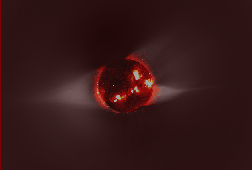Blending of an eclipse image (from the High Altitude Observatory) with a Yohkoh X-ray image (from the Yohkoh Science Team).
Click on image for full size
Image courtesy of the High Altitude Observatory, National Center for Atmospheric Research (NCAR), Boulder, Colorado,
The Solar Corona
Rising above the Sun's chromosphere ,
the temperature jumps sharply from a few tens of thousands of kelvins
to as much as a few million kelvins in the Sun's outer atmosphere,
the solar corona. Understanding the reason the Sun's corona
is so hot is one of the many challenges facing solar physicists today.
Because of the very high temperatures, the corona emits high
energy radiation and can be observed in X-rays. The Earth's
atmosphere absorbs X-rays, but satellites above the atmosphere,
such as the Yohkoh spacecraft, can observe the Sun in these
wavelengths. Shown on the left is a blending of a Yohkoh
X-ray image (reddish colors) with an
eclipse image taken by
the High Altitude Observatory (gray-white colors) on November 3, 1994.
Near the poles of the Sun, the corona is dark for both X-rays and white light.
These regions are coronal holes and are
the source of the solar wind that extends out into
interplanetary space. The scattered white light
shows the density of plasma in the corona. The large white regions extending
out far from the Sun are helmet streamers,
where the solar plasma has been trapped by the Sun's magnetic field.
You might also be interested in:
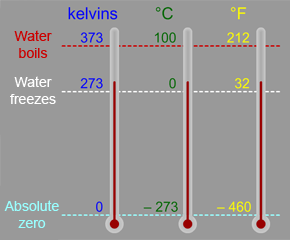
The Kelvin scale is a temperature scale that is often used in astronomy and space science. You are probably more familiar with the Celsius (or Centigrade) scale, which is part of the metric system of measures,
...more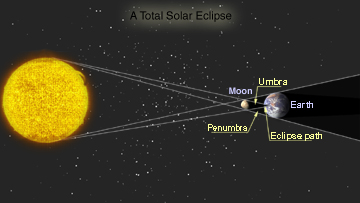
An eclipse of the Sun occurs when the Earth passes through the Moon's shadow. A total eclipse of the Sun takes place only during a new moon, when the Moon is directly between the Sun and the Earth. When
...more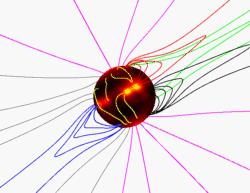
The gas in the solar corona is at very high temperatures (typically 1-2 million kelvins in most regions) so it is almost completely in a plasma state (made up of charged particles, mostly protons and electrons).
...more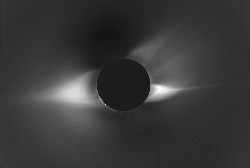
The last solar eclipse of this millennium occurred on August 11, 1999. Amateurs and scientists witnessed a truly awesome site. This was a total eclipse, which means the Moon completely covered the Sun.
...more
There is a solar eclipse coming to a movie theater near you! Actually, this is better than a theater! This is the real thing! There will be a total solar eclipse on February 26th. The total eclipse will
...more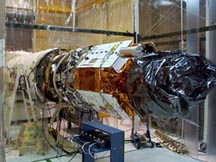
On March 30, 1998, the TRACE spacecraft will be launched. TRACE stands for Transition Region and Coronal Explorer (try saying that fast three times!). This spacecraft has four telescopes on it. The telescopes
...more
The TRACE spacecraft was launched April 1st at 9:42 p.m. EST from the central California coast. TRACE stands for Transition Region and Coronal Explorer (try saying that fast three times!). This spacecraft
...more


